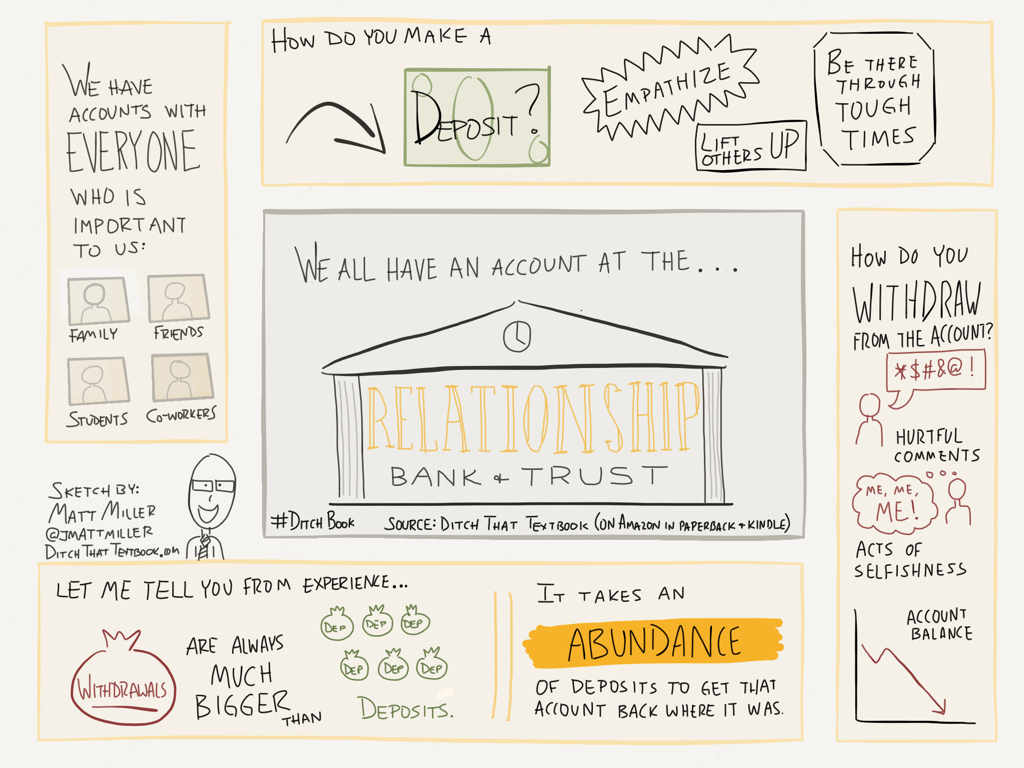

The capital of student/teacher relationships is interactions, and there are deposits AND withdrawals. (Sketch by Matt Miller)
On the first day of school every year, I open lots of new accounts at the Relationship Bank and Trust.
When a new student enters my classroom door, a new account is active. With some students I’ve seen in the halls or already know, their accounts already have a balance.
A simple smile and “hello” at the door puts a positive balance in the account. Making a comment about an activity that student’s in or a band or character on his/her t-shirt is like a double deposit.
As my teaching career has progressed, I’ve learned two very important lessons:
At some point, I realized that teacher/student relationships build a kind of momentum. Positive interactions build upon each other. Negative interactions destroy the work of previous positive interactions.
It dawned on me: those relationships are like bank accounts. We make deposits when we do anything to show students we care about them. Negative interactions are like big withdrawals that drastically drop our account balances.
This is an idea I wrote about in my book, Ditch That Textbook, in a chapter titled, “Build Respect and Relationships.”
In my teaching career, I’ve had really high relationship balances. I’ve also had some negative balances where I’ve been very deep in the hole.
An example of a very rich relationship account: a student we’ll call Steven. I’ve learned about some of his interests (namely racing four wheelers and geckos) and we’ve talked at length about them. Deposit.
I recently helped him design an advertisement for class officer elections with a cool Google Slides template on Slides Carnival. Deposit.
The interest I get on the account? He tells me how much he enjoys my class and learns in it and how he wishes other teachers would teach like me. I think (or at least hope!) every teacher has a dream kid like this in their professional lives.
Not every relationship has had such a million-dollar balance.
An example of an account with a deep negative balance: a student we’ll call Leigh. Nothing I did in the classroom caught her interest and she often left less than engaged. Withdrawal.
I called her out for talking in class once and assigned her extra work. Then, to make matters worse, when she balked at it, I told her, “It’s not like cutting your arm off. Just do it.” In front of the whole class.
BIG withdrawal. She closed her account after that. I never got a real chance to connect with her again.
I’ve learned a lot about managing my relationship finances as a teacher. The biggest lesson is to made little deposits whenever possible:
Those are the lessons I’ve learned, and they’re probably obvious ones, but they’re not the only ways to make a deposit.
I have found that if you make regular deposits, you’ll be rich beyond your wildest dreams in the classroom.
[reminder]What are the ways you make deposits in your student relationship bank accounts? What suggestions do you have for avoiding withdrawals?[/reminder]Hannah Tyreman, a wonderful member of my personal/professional learning network on Twitter, mentioned me in a blog post called the Twitterati Challenge. I was honored and humbled at her comments about my work and how it “strikes a chord” with her.
The mention also meant that it’s now my turn. Here are the rules from @teachertoolkit:
What to do?
Here are my five nominations for the Twitterati Challenge:
If this Twitterati Challenge idea sounds like fun, copy down the rules and start tagging some people of your own. Who knows whose day, week or year you could make?
For notifications of new Ditch That Textbook content and helpful links:
Interested in having Matt present at your event or school? Contact him by e-mail!
Matt is scheduled to present at the following upcoming events:
[getnoticed-event-table scope=”all” expanding=”false”]
Session expired
Please log in again. The login page will open in a new tab. After logging in you can close it and return to this page.
Your Twitterati Challenge post is fab- lots of new people for me to follow and some great reasons too! 🙂
This is what I love about using TPRS/CI instruction. I feel like I actually get to know my students so much better than with the textbook. Making deposits is an ingrained part of my class through PQA. Today for a warm-up I asked my 3rd years “What makes you happy?/Was macht dich gluecklich?” and I went around and talked with each student briefly about what they answered. Maybe it’s just a small deposit each day but first semester I was deep in the red with that entire class, and now I feel I have a positive balance. I’m sure we can’t be everywhere at once, but attending concerts, sporting events etc also makes a big difference!
Anna, this is a GREAT example of little deposits on a regular basis. You’re accomplishing two goals: building a lasting relationship with students AND providing comprehensible input in a new language. This is what makes education meaningful! Keep up the great work.
Deposits come from acknowledging honest effort, listening to hear their learning concerns and offering suggestions, listening to hear the things dominating their worlds (listening, NOT listening IN) and showing empathy.
Deposits are so very important. Withdrawals WILL happen in spite of our best intentions!!!